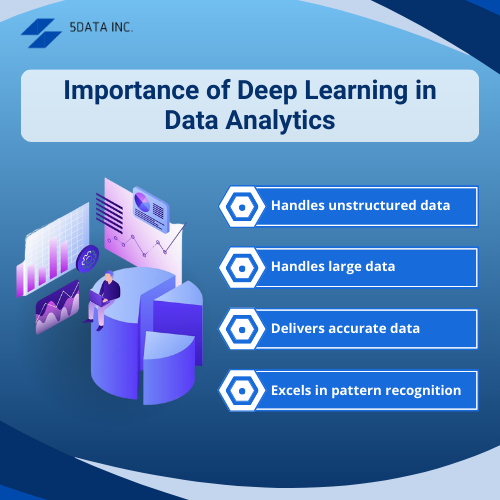Deep Learning
Imagine a world where machines can learn from data and perform tasks that were once considered the domain of human intelligence. Deep learning is a cutting-edge tool in the field of artificial intelligence and decision-making. Deep learning is built on a foundation of various artificial intelligence computational models and neural networks that replicate the function and structure of the human brain. In this article, we’ll take you on a journey through the basics of deep learning, unraveling the mysteries of neural networks and providing a stepping stone for beginners to enter this thrilling field.
Key Takeaways
Understanding deep learning concepts.
Understanding artificial neural network’s performance.
Key concepts and building blocks of neural network training.
Applications and frameworks leveraging neural networks and deep learning.
Importance Of Deep Learning In Data Analytics
Here are the key reasons why deep learning has become the industry standard:
1. Handling unstructured data: Deep learning models are adept at learning from unstructured data, saving time and resources typically required to standardize data sets.
2. Handling large data: Thanks to the introduction of graphics processing units (GPUs), deep learning models can swiftly process large volumes of data.
3. High accuracy: Deep learning models consistently deliver highly accurate results in computer vision, natural language processing (NLP), speech recognition, and audio processing.
4. Pattern recognition: Deep learning models excel at speech recognition, automatically detecting a wide range of patterns in diverse datasets, reducing the need for manual intervention by machine learning engineers.

Understanding Neural Networks
Neural networks are central to deep learning algorithms. These networks are made up of interconnected nodes, or neurons, arranged in multiple layers together. To give you a real-world analogy, think of a neural network as a team of specialists working together to solve a problem. Each specialist or node in training neural networks has a specific role to play. Software service experts like Data life cycle management services provide the necessary assistance to decode the algorithms.
The layers in a neural network include:
1. Input layer: The first layer of the neural network is where input data is transformed. Every node in this layer represents a feature or input variable of sequential data.
2. Hidden layers: The hidden layers form the intermediate layers flowing through the input and output layers, where the computation takes place. The nodes in the hidden layer transform the input data using a set of biases and weights.
3. Output layer: The o/p layer is the final layer of the neural network, producing the desired outputs or generating predictions. The number of nodes in the neural network training this layer depends on the nature of the task, such as classification or regression.
The Building Blocks: Key Concepts Of Neural Network
Mentioned below are the key elements of recurrent neural networks.
- Neurons are the crucial computation units in a neural network model. They process multiple inputs through an activation function to produce a single output.
- Weights represent the influence of each input on the output and are assigned numerical values for each connection between neurons.
- Backpropagation is an essential algorithm used to train a neural network by adjusting weights based on prediction errors.
- Common activation functions, such as the ReLU (rectified linear unit), sigmoid, and tanh functions, play a vital role in mapping inputs and modeling complex relationships to outputs.
- Convolutional Neural Networks (CNNs) are specifically designed to analyze spatial patterns in data, such as images or videos, and surveillance systems.
- Generative Adversarial Networks (GANs) are powerful architectures that generate synthetic data from real data, utilizing a generator network and a discriminator network.
- Recurrent Neural Networks (RNNs) are uniquely designed to analyze temporal sequences in data, making them ideal for machine translation, natural language processing tasks, and time series analysis tasks.
Deep Learning Applications
Deep learning technology is widely applicable across computational models inspired by diverse fields with the assistance of data collection And data management service providers:
1. Computer vision: It encompasses image classification, object detection, image recognition, and image generation.
2. Natural language processing (NLP): NLP includes machine language translation, sentiment analysis language translation, and language modeling.
3. Healthcare: Deep learning is instrumental in disease diagnosis from medical imaging images, drug discovery, and personalized treatment plans.
4. Autonomous systems: Its applications extend from autonomous vehicles to self-driving cars, autonomous vehicles, and robotics.
Tools And Frameworks
Several tools and frameworks facilitate the development and training of deep learning models:
- TensorFlow: Developed by Google, it’s one of the most popular deep learning models.
- PyTorch: Developed by Facebook, it is known for its dynamic computational graph and ease of use.
- Keras: A high-level API for neural networks running on top of TensorFlow or other frameworks.
- Caffe: Developed by Berkeley AI Research, it is commonly used for image classification.
Conclusion
Deep learning, along with neural networks, plays a crucial role in numerous advanced AI applications. While this beginner’s guide lays the groundwork for understanding these concepts, it’s essential to pursue additional study through online courses, tutorials, and practical projects to gain proficiency. With dedication and practice, one can unleash the potential of neural networks and make valuable contributions to the dynamic field of various deep learning applications and computational demands.
Frequently Asked Questions
What are the basics of deep learning neural networks for beginners?
Deep learning neural networks are essential in machine learning, using interconnected neurons to process data. Beginners should understand layers, neurons, and the hierarchical learning process. Key types include feedforward, CNNs for images, and RNNs for sequences, enabling complex data analysis.
Is ChatGPT a neural network?
Yes, ChatGPT is indeed a neural network. Specifically, ChatGPT is a natural language processing model that harnesses the power of a neural network to understand and generate conversational responses based on user text prompts. This neural network, based on the transformer architecture, is a key component of ChatGPT’s ability to process text data efficiently and generate human-like responses.
How can a beginner learn deep neural networks?
For those with a basic understanding of mathematics, diving into deep learning is a great starting point. However, to progress to intermediate and advanced levels, a comprehensive knowledge of machine learning literature, algorithms, and frameworks like TensorFlow and PyTorch is essential.
What is the concept of deep learning?
Deep learning represents the next layer of an advanced approach that utilizes artificial intelligence networks to model complex problems effectively. At its core, these artificial neural networks are comprised of interconnected layers of nodes or neuronal cells resembling human brain structures. The defining characteristic of the deep learning approach is its inherent complexity.
Why is it so hard to learn neural networks?
It is crucial to delve into their intricate workings to develop a comprehensive understanding of neural networks. These networks, which draw inspiration from the complexity of our brains, are composed of sophisticated components that underpin a new era of AI technology. The process commences with the input layer, akin to our senses, serving as the conduit for raw data from the external environment. This layer acts as a gateway, absorbing and transmitting data through the subsequent hidden layers, mirroring the intricate processing that occurs in the brain. Within these hidden layers, more intricate patterns and transformations occur, enabling the network to discern complex relationships, patterns, and representations within data sets and information structures.

